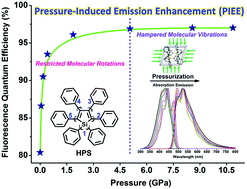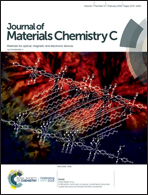Pressure-induced emission enhancement in hexaphenylsilole: a computational study†
Abstract
Organic mechano-responsive luminescent materials have aroused wide attention in recent years for their tremendous utilities. Pressure-induced emission enhancement (PIEE) refers to a novel phenomenon whereby a solid-state luminogen exhibits enhanced emission intensity upon compression, in contrast to the conventional pressure-caused luminescence quenching. The mechanism behind PIEE remains unclear. It is desirable to unravel the effects of pressurization on the optical emission for molecular materials. Here, we carried out an in-depth theoretical investigation on the excited-state decay processes of crystalline hexaphenylsilole (HPS) at high pressure by combining dispersion-corrected density functional theory (DFT-D) crystalline-structure simulations, hybrid quantum mechanics/molecular mechanics (QM/MM) calculations and our thermal vibration correlation function formalism. It was found that the fluorescence quantum efficiency first increases sharply and then levels off as the pressure rises from ambient to 10.86 GPa. This is because the molecular electron–vibration couplings of low-frequency modes (<200 cm−1) are remarkably reduced owing to the pressure-triggered closer molecular packing, slowing down the non-radiative process. When the pressure rises above 5.06 GPa, the electron–vibration couplings of low-frequency modes gradually reach a plateau, although those of high-frequency modes (1400–1800 cm−1) start to decrease slightly, resulting in the saturation of the non-radiative rate constant. Resonance Raman spectroscopy is suggested to probe the above hypothesis in unravelling the PIEE mechanism of HPS. At the same time, a theoretical protocol is proposed to quantitively predict the PIEE properties, thus aiding the rational design of advanced PIEE materials.



 Please wait while we load your content...
Please wait while we load your content...